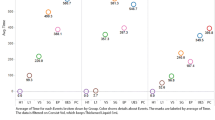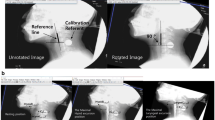Abstract
Recently, we described three components of a normal pharyngeal swallowing sound. The aim of the present study was to identify variations of these components using synchronized acoustic-radiological data in partially laryngectomized (PL) and totally laryngectomized (TL) patients before and after surgery. In this prospective study, from January 2003 to December 2006 we enrolled 14 patients in a PL group and 9 patients in a TL group. A fluoroscopy camera and a microphone were connected to a computer to obtain acoustic-radiological data (25 images/s). The subjects were asked to perform six deglutitions of 10 ml of barium suspension. The average durations of the sound variables were measured before and after surgery. The duration of the preoperative pharyngeal sound was 602 ms in the PL group and 562 ms in the TL group. It was significantly decreased after the TL (296 ms) and was increased after the PL (740 ms). A typical profile of the swallowing sound for each group was obtained. This study allowed us to describe the main variations of the pharyngeal swallowing sound induced by PL and TL. This noninvasive tool could be useful to assess postoperative swallowing function.



Similar content being viewed by others
References
Mac Lean DL, Cotton S, Perry A. Post-laryngectomy: it’s hard to swallow. Dysphagia. 2009;24:172–9.
Logemann JA, Gibbons P, Rademaker AW, Pauloski BR, Kahrilas PJ, Bacon M, Bowman J, McCracken E. Mechanism of recovery of swallow after supraglottic laryngectomy. J Speech Hear Res. 1994;37:965–74.
Schindler A, Favero E, Capaccio P, Albera R, Cavalot AL, Ottaviani F. Supracricoid laryngectomy: age influence on long-term functional results. Laryngoscope. 2009;119:1218–25.
Morinière S, Boiron M, Beutter P. Sound component duration of healthy human pharyngoesophageal swallowing: a gender comparison study. Dysphagia. 2006;21:175–82.
Morinière S, Boiron M, Alison D, Makris P, Beutter P. Origin of the sound component during pharyngeal swallowing in normal subjects. Dysphagia. 2008;23:267–73.
Leslie P, Drinnan MJ, Zammit-Maempel I, Coyle JL, Ford GA, Wilson JA. Cervical auscultation synchronized with images from endoscopy swallow evaluation. Dysphagia. 2007;22:290–8.
Roubeau B, Morinière S, Périé S, Martineau A, Falières J, St Guily JL. Use of reaction time in the temporal analysis of normal swallowing. Dysphagia. 2008;23:102–9.
Selley WG, Ellis RE, Flack FC, Bayliss CR, Pearce VR. The synchronization of respiration and swallow sounds with videofluoroscopy during swallowing. Dysphagia. 1994;9:162–7.
Ford S, Gollins S, Hobson P, Vyas S. Structural displacements during the swallow in patients with early laryngeal cancers and other early primary cancers of the head and neck. Dysphagia. 2009;24:127–36.
Pauloski BR, Rademaker A, Logemann JA, Stein D, Beery Q, Newman L, Hanchett C, Tusant S, MacCracken E. Pretreatment swallowing function in patients with head and neck cancer. Head Neck. 2000;22:474–82.
Mittal BB, Pauloski BR, Haraf DJ, Pelzer HJ, Argiris A, Vokes EE, Rademaker A, Logemann JA. Swallowing dysfunction–preventative and rehabilitation strategies in patients with head-and-neck cancers treated with surgery, radiotherapy, and chemotherapy: a critical review. Int J Radiat Oncol Biol Phys. 2003;57:1219–30.
Woisard V, Puech M, Yardeni E, Serrano E, Pessey JJ. Deglutition after supracricoid laryngectomy: compensatory mechanisms and sequelae. Dysphagia. 1996;11:265–9.
Maclean J, Cotton S, Perry A. Dysphagia following a total laryngectomy: the effect on quality of life, functioning, and psychological well-being. Dysphagia. 2009;24:314–21.
Hui Y, Ma KM, Wei WI, Ho WK, Yuen PW, Lam LK, Chow CM. Relationship between the size of neopharynx after laryngectomy and long-term swallowing function: an assessment by scintigraphy. Otolaryngol Head Neck Surg. 2001;124:225–9.
Hamlet SL, Patterson RL, Fleming SM, Jones LA. Sounds of swallowing following total laryngectomy. Dysphagia. 1992;7:160–5.
Charbonneau I, Lund JP, Mcfarland DH. Persistence of respiratory-swallowing coordination after laryngectomy. J Speech Hear Res. 2005;48:34–44.
Hiss SG, Strauss M, Treole K, Stuart A, Boutilier S. Swallowing apnea as a function of airway closure. Dysphagia. 2003;18:293–300.
Cichero JAY, Murdoch BE. What happens after the swallow? Introducing the glottal release sound. J Med Speech Lang Pathol. 2003;11:31–41.
Acknowledgment
The authors thank Dr. Musaed Al Zahrani for correcting the English grammar and spelling in the manuscript.
Author information
Authors and Affiliations
Corresponding author
Rights and permissions
About this article
Cite this article
Morinière, S., Boiron, M., Brunereau, L. et al. Pharyngeal Swallowing Sound Profile Assessed after Partial and Total Laryngectomy. Dysphagia 26, 366–373 (2011). https://doi.org/10.1007/s00455-010-9322-0
Received:
Accepted:
Published:
Issue Date:
DOI: https://doi.org/10.1007/s00455-010-9322-0




